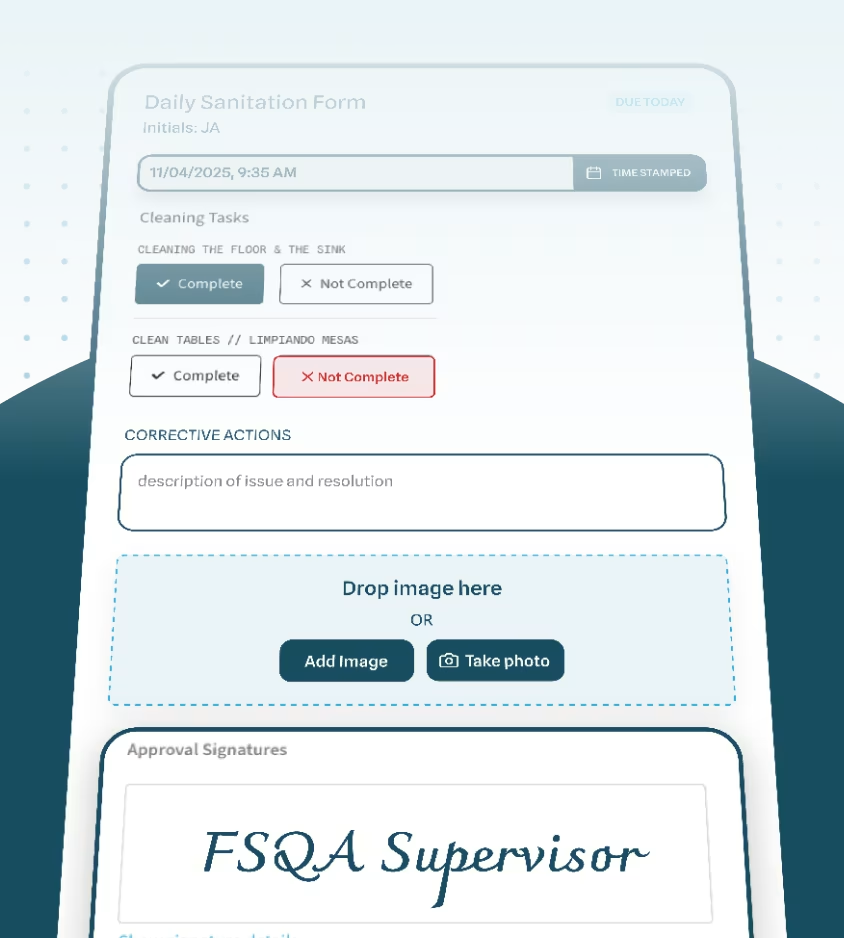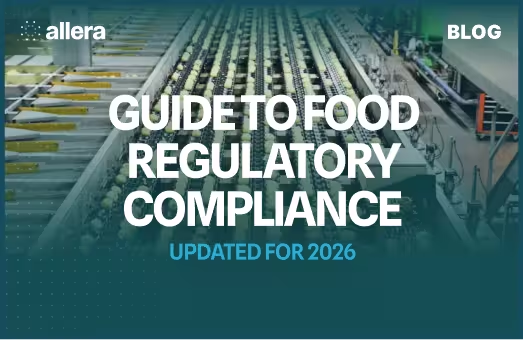

Quality Control vs. Quality Assurance: What Food Manufacturers Need to Know
.avif)
Key Takeaways:
- Food quality control focuses on real-time inspection, testing, and identifying defects.
- Quality assurance emphasizes processes, documentation, and preventing mistakes before they happen.
- Both are essential for consistent, safe food production.
- Combining both helps spot immediate issues while driving long-term improvements.
- Digital tools reduce errors, cut paperwork, and simplify compliance.
The title may make you think QA and QC are competing subjects, but in-fact the best-performing food manufacturers use both food quality control (QC) and quality assurance (QA) to maintain the highest standards. Let’s break down their differences, roles, and how to build a combined strategy that keeps your operation compliant and audit-ready.
Understanding Food Quality Control vs. Quality Assurance in Manufacturing
Quality control (QC) and quality assurance (QA) often get confused, but they play distinct roles in food manufacturing.
- Food quality control means inspecting and testing finished goods—like checking if a cake is the right texture, flavor, and size.
- Quality assurance focuses on preventing problems before they occur—like monitoring oven temperature and measuring ingredients correctly so the cake turns out right.
Think of them as two sides of the same coin. A 2024 survey of 300 food and beverage companies found that 82% used QC checks for finished products, while 67% also relied on QA practices to guide processes (Food Engineering Magazine, 2024). This shows that most manufacturers blend both approaches to ensure safety and consistency.
The history of QC and QA in food safety
The modern food industry didn’t always distinguish clearly between QC and QA. In the early 20th century, most companies relied solely on inspection-based systems—workers visually checked goods before packaging. However, as food safety scandals grew and regulatory agencies like the FDA and USDA expanded oversight, companies realized inspection alone wasn’t enough.
By the 1960s, preventive frameworks like HACCP (Hazard Analysis and Critical Control Points) became standard, emphasizing QA practices such as identifying hazards, establishing preventive measures, and verifying compliance. Over time, QA has become a proactive backbone of modern manufacturing, while QC still serves as the necessary final checkpoint.
Best Practices for Quality Control vs. Quality Assurance
Food quality control best practices
- Inspects end products
- Identifies visible or measurable defects (like contamination or packaging issues)
- Provides immediate pass/fail feedback
Food quality assurance best practices
- Develops and maintains SOPs (standard operating procedures)
- Trains staff to follow best practices
- Focuses on compliance and continuous improvement
Relying too heavily on one method creates risks. QC alone may catch flaws too late, while QA alone can overlook hidden, real-time issues. Blending both ensures you act quickly on problems and refine systems to stop them from repeating.
Examples from real-world food manufacturers
- A dairy plant might use QC checks to test pasteurized milk for microbial contamination before bottling. Meanwhile, QA protocols ensure staff are trained in pasteurization equipment cleaning procedures.
- A bakery could rely on QC inspectors to check loaf size and crust quality, while QA teams develop process controls for ingredient sourcing, ensuring consistency across suppliers.
Both levels of protection reinforce one another, reducing recalls and improving consumer trust.
Comparing Roles: Food Quality Control vs. Quality Assurance Teams
Instead of a table, here’s a side-by-side breakdown:
Food Quality Control (QC):
- Core Purpose: Identify and remove defective products.
- Typical Activities: Product inspections, lab testing, end-of-line checks.
- Timing: End-of-line or during production.
- Key Metrics: Rejection rates, defect counts.
- Documentation: Test results, defect logs.
Quality Assurance (QA):
- Core Purpose: Prevent issues by refining processes.
- Typical Activities: Auditing SOPs, staff training, compliance monitoring.
- Timing: Throughout the production cycle.
- Key Metrics: Audit scores, SOP adherence.
- Documentation: Policies, training manuals, CAPA programs.
For example, QC staff might run microbial tests on random batches, while QA teams ensure HACCP requirements are followed and documentation stays current with FDA food safety regulations. Together, they provide a holistic food safety system.
Why these roles often overlap
In smaller food companies, QC and QA responsibilities are sometimes handled by the same staff. For example, a production supervisor might both record sanitation checks (QC) and also write SOPs (QA). While this overlap may save costs initially, it increases the risk of missed details. Larger facilities typically separate the two functions, ensuring stronger checks and balances.
Practical Steps to Strengthen Food QC and QA Systems
Step 1: Begin with clear SOPs
- Draft or update guidelines with checklists and limits (e.g., proper storage temperatures).
- Train staff regularly—studies show consistent training reduces defect rates by up to 15% (Journal of Food Protection, 2023).
- Revise SOPs when QC feedback highlights recurring issues.
Pro tip: Avoid messy versioning with Document Control Software. Keep SOPs, checklists, and certificates organized with audit trails and approvals.
Step 2: Incorporate real-time monitoring
- Use inline checks at critical control points (e.g., pasteurization temperatures).
- Establish feedback loops so QC findings inform QA updates.
Step 3: Track data consistently
- Automate defect and compliance logs with digital platforms.
- Create a shared dashboard for QC and QA teams to spot trends together.
Step 4: Integrate supplier management
Even the best in-house QA/QC systems can fail if raw materials are inconsistent. Automating supplier management ensures certificates, ingredient testing, and onboarding are streamlined. Platforms like Allera’s supplier management save time and reduce compliance risks.
Common Pitfalls in Food Quality Systems
- Waiting for failures: Relying only on QC creates costly recalls. QA prevents root causes.
- Over depending on automation: Software is powerful, but trained staff catch what machines miss.
- Neglecting continuous improvement: QA systems should evolve with new risks and regulations.
- Insufficient communication: Silos between QC and QA delay solutions—cross-team huddles keep everyone aligned.
Case study example: Epicurean Butter
Epicurean Butter streamlined document management and supplier compliance with Allera’s platform. By reducing manual tracking, they improved both QC response times and QA documentation readiness, keeping them consistently audit-ready.
Combining QC and QA for Compliance Success
Step 1: Link QA and QC teams
Encourage collaboration between process-focused QA specialists and defect-spotting QC staff. Monthly reviews align both groups.
Step 2: Use CAPA programs
Corrective and Preventive Actions (CAPA) help address immediate issues while preventing repeat problems.
Step 3: Monitor performance with metrics
- QA leading indicators: Staff trainings completed, updated SOPs.
- QC lagging indicators: Final defect rates, shelf-life test results, customer complaints.
Step 4: Build a culture of quality
Long-term success requires more than processes—it requires mindset. Embedding quality at every level of staff culture ensures both QA and QC become habits, not just requirements.
Quality Assurance in Food Manufacturing: Key Benefits
Benefits of food quality control
- Immediate detection of product flaws
- Easy-to-measure metrics (contamination rates, defect counts)
- Direct impact on consumer safety and acceptance
Benefits of food quality assurance
- Prevents costly errors through stronger processes
- Essential for regulatory compliance (HACCP, FSMA)
- Scalable for multi-line or multi-site operations
Looking to simplify compliance? Allera’s Document Control Software automates version control and ensures training materials stay current.
Why QC and QA Matter for Compliance and Profitability
Strong QC and QA systems don’t just protect compliance—they protect profits. A 2023 food industry study showed companies with mature quality systems had a 20% higher repeat order rate thanks to consumer trust (Food Safety Magazine, 2023).
QA prevents costly waste by catching mistakes early, while QC stops defective goods from reaching customers, avoiding recalls and liability.
Cost savings and efficiency
Research shows that companies with robust QA programs spend 25% less on recalls and rework compared to companies without integrated systems (FSIS, USDA). These savings compound year after year.
Practical Expansion: Real-World Scenarios
- Frozen food plant: QC detects freezer burn issues, while QA ensures regular equipment maintenance schedules prevent them from recurring.
- Meat processor: QC tests bacterial levels in batches, while QA maintains supplier audit trails and HACCP documentation.
- Snack company: QC tracks package seal integrity, while QA updates SOPs to prevent recurring sealing machine malfunctions.
These scenarios highlight how the two systems are always stronger together.
The Verdict: Adopting Both QA and QC
Choosing one over the other creates blind spots. Together, QC and QA form the backbone of a strong food safety management system. QC addresses immediate product safety, while quality assurance builds a culture of continuous improvement.
Conclusion: Stay Audit-Ready with the Right Tools
By combining food quality control and assurance, you’ll safeguard your production lines and maintain trust with consumers. To make the process easier, Allera Technologies offers tools like Document Control and supplier management automation to keep your facility audit-ready year-round.
With both systems in place, your food business won’t just meet compliance—it will lead with quality.
FAQs
What does QA do in the food industry?
QA teams in the food industry develop and enforce policies to maintain consistent food safety and quality. They monitor production lines, conduct inspections, verify sanitation procedures, check supplier compliance, and manage documentation for audits. QA also investigates consumer complaints, trains employees on food safety protocols, and ensures compliance with standards such as FDA, USDA, SQF, or BRCGS.




.avif)


.avif)

.avif)


.avif)